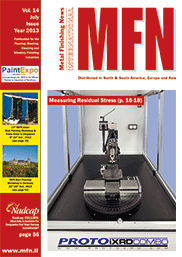E-Archive
Shot Peening in the Automotive Industry
in Vol. 14 - July Issue - Year 2013
Shot Peening And Roughness

Mario Guagliano
We all know that the main effects of shot peening on metallic parts are the introduction of a compressive residual stress field in the surface layer and surface work hardening. The beneficial influence of shot peening on the fatigue behavior of materials is related to these effects. In particular, residual stresses are able to stop or delay crack propagation: this is the reason why in fatigue testing of parts previously shot peened (mainly notched parts), it is possible to observe, after the test, a series of not propagated short cracks, that is to say that the main effect of shot peening was not to avoid crack initiation but to stop crack propagation. On the other hand, surface work hardening generally means the improvement of the ability of the material to resist crack initiation. The relative importance of these two effects depends on the material and on the geometry of the peened part. When the base material has poor initial properties, the beneficial effects can be mainly attributed to the surface work-hardening; in fact, the residual stresses will partially relax after the application of the first thousands cycles, while if a more resistant material is considered, possibly hardened by some thermochemical treatment before shot peening, residual stresses are more stable and their effect on fatigue strength more evident. In any case, their effect is less evident in smooth parts, where, due to the low (or null, in axial fatigue) stress gradient, shot peening is only able to shift the crack initiation point from the surface in some sub-surface zone, where some pre-existent material defect acts as a pre-existent crack. On the contrary, when severe notches have to be considered, the steep stress gradient makes the crack initiation point remain on the surface, with a considerable advantage in terms of applicable stress and improved fatigue strength.
However, residual stresses and surface work hardening are not the only effects of shot peening. There is at least another valuable effect induced by shot peening: roughness.
This latter can be defined as a side effect and indeed it is, most times, an unwanted effect: roughness is a detrimental factor for fatigue!
The problem is mainly of interest when shot peening is applied to hardened surfaces; for instance when shot peening is applied to a carburized surface, the roughness will remain low and its detrimental effect negligible with respect to the beneficial ones due to residual stresses and work hardening. Nevertheless, if you consider a non-hardened surface, roughness can play a key role in determining the effective improvement of the fatigue strength of peened parts.
This means that the shot peening parameters should be chosen by considering also the induced roughness: studies exist showing that using peening parameters results in a less important residual stress field, but even using reduced roughness is more effective than deeper residual stress fields with a higher associated roughness.
There is another factor concerning roughness of shot peened parts that should be considered.
The effect of roughness in fatigue design is quantified by the so-called surface coefficient that depends mainly on the peak-to-valley roughness value and on the static tensile properties of the material of interest. But the surface coefficient values commonly used in fatigue design were determined by considering common machining operations, like turning and grinding - not shot peening! And if you use them when you have to deal with a peened surface characterized by known surface roughness parameters, you probably won’t obtain reliable results. This means that the usual roughness parameters do not completely describe the surface state of a peened part and that more refined investigations are required to completely understand the role played by roughness in determining the effective fatigue behaviour of a peened part.
Modern 3D digital devices can help, but investments are required. At any rate, the results could open new horizons in shot peening applications in automotive and other industries.
Shot Peening in the Automotive Industry
by Mario Guagliano
Contributing Editor MFN and
Associate Professor of Technical University of Milan
20156 Milan, Italy
E-mail: mario@mfn.li
Author: Mario Guagliano




























